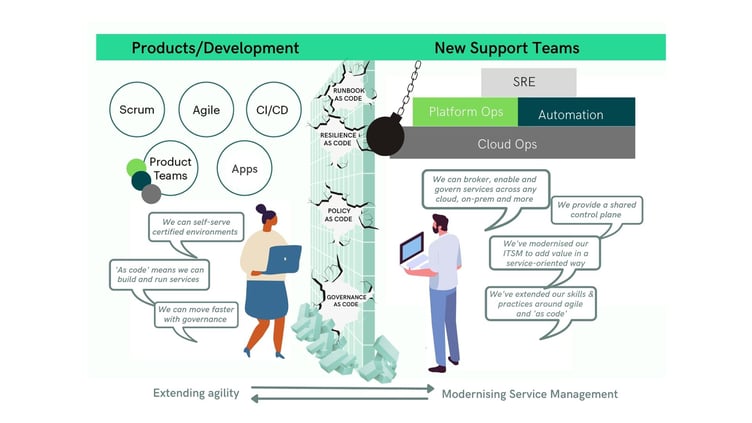Environment-as-Code: Why DevOps principles should be applied to your entire IT environment.
/4.png?width=200&name=4.png)
In a world where hybrid IT is the norm and applications can be deployed on any platform or environment, it's more important than ever to have an automated way to manage your applications in those environments, as well as the environments themselves.
Infrastructure-as-Code (IaC) has been around for a while, helping teams to provision infrastructure consistently and remove manual effort. However for complex organisations it may no longer be enough. To truly automate and optimise your IT environment, you need to move to Environment-as-Code (EaC).
In this blog post, we'll explore the differences between Infrastructure-as-Code and Environment-as-Code and explain not only why DevOps principles should be applied to the entire IT environment but how to bridge the DevOps/Infrastructure and Operations (I&O) divide with Environment-as-Code.
Infrastructure-as-Code vs Environment-as-Code
DevOps seeks to increase efficiency and agility by achieving simultaneous development and operations. IaC approaches help with DevOps because it allows you to treat your entire infrastructure as if it were a piece of software, rather than a combination of physical & virtual machines.
This *should* simplify development pipelines, speed up error detection and resolution and shorten release cycles. And it does, especially for born-in-the-cloud companies. But if you're running 50 year old mainframes as well as Serverless apps, in amongst a vast and complex array of on-prem, legacy, public cloud and containerised deployments then Infrastructure-as-Code may not be enough.
You need Environment-as-Code.
Environment-as-Code elevates Infrastructure-as-Code, applying DevOps methods and tools to the entire production environment as opposed to only the infrastructure. This helps to connect DevOps teams, tasked with product delivery and innovation, with their Infrastructure and Operations counterparts; allowing I&O to deliver, manage and orchestrate environments, platforms and services rapidly, reliably, resiliently and at scale.
Connecting DevOps with I&O
As cloud adoption has rapidly grown, the traditional infrastructure administration and management skills required by I&O teams have been largely subsumed by cloud service providers.
According to Gartner, by the end of this year (2022) at least 35% of I&O staff must possess the software engineering skills to deliver the pace of innovation demanded by the business, and in a recent survey of CIOs ranked skills gaps as their top priority for the coming years.
However, I&O teams still play a hugely important role in ensuring governance, compliance and security. Environment-as-Code helps to modernise ITSM, placing I&O in a better position to meet the needs of DevOps and Product teams:

So how does Environment-as-Code fit into this?
Cloud is about agility - and EaC brings the public cloud experience to legacy environments. Expressing your environments as code enables agile delivery but with governance. And this governance can also be extended to public cloud through self-service, meaning developer teams can continue to go faster but with confidence and compliance.
Environment-as-Code in practice
In practice, EaC means that I&O teams can establish consistent guardrails and governance for all their environments. They can use EaC to codify best practices, policies, processes, runbooks and more into reusable elements. In Cloudsoft AMP, we call this a blueprint. AMP's blueprint repository stores these elements, and development teams can choose the ones which work for them whilst they're composing their applications.
AMP takes this a step further with automation. You can also codify your policies, and these can be attached to the blueprint enabling automated, zero-touch Day-2 operations and dynamic observability.
For example if a data centre suffers an outage, AMP will immediately sense the issue and then automatically effect the failover and recovery policies governing what happens to the applications running from that data centre.
In complex IT environments where something is failing all the time, and the costs of such failures average $2.5bn a year, this 99% reduction in unplanned downtime is a huge win. And AMP operates at scale - one of our Tier 1 banking customers used AMP to successfully run their biggest ever disaster recovery test in AWS. This involved simulating a failure to test the orchestrated failover and recovery for 10,000 VMs.
So what are the benefits of Environment-as-Code?
- Governance and orchestration for complex hybrid IT.
- Create self-service, certified environments for developers.
- Bring DevOps agility to I&O.
- Bring governance and control to DevOps.
- Improve agility & observability.
- Demonstrate resilience and compliance.
Environment-as-Code with Cloudsoft AMP
Cloudsoft AMP is powerful automation software which lets you seamlessly orchestrate and govern your critical IT services across complex hybrid IT environments.
By sitting above, and integrating with, your best-in-class tools, AMP operates at scale to provide a single control plane for the multiple technologies you manage; anticipating, monitoring, responding and restoring.
